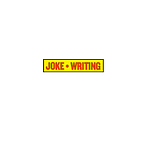Writing Jokes with Charlie Hankin (The New Yorker)
Mechanics aside, I think a funny cartoon is drawn funny.
[@mecharliehankin on Instagram]
- Can you describe your general process for creating cartoons?
My cartoons start as one-sentence descriptions I write in my notebook. I’ll sit down at a cafe or go for a long walk and just let my mind wander. I know I have a potential cartoon when: 1) I’ve constructed a joke (say, a sperm realtor talking to two sperm house hunters in front of an available ovum, saying “It’s perfect for starting a family.”); and 2) I can visualize the picture that goes with it (the “for sale” sign out front, a little tie and clipboard for the sperm realtor). Some cartoonists just start with a blank sheet of paper and doodle until they arrive at a picture that becomes their cartoon. I’ve never worked that way — I think writing a joke out verbally, in longhand, is a better way for me to be sure that the thing actually is a proper joke, as opposed to something whimsical, charming, associational, et cetera… all words that are nice but don’t include “funny.”
Once I have a collection of jokes, I’ll sit down and draw them all out at once. It usually takes me all day to draw sketches of 10 new cartoons, and another day to draw cleaned-up versions. I used to work entirely in traditional media, but now I work with a digital tablet and Photoshop.
When The New Yorker buys a cartoon for publication, I will redraw it at top quality using conventional tools — India ink on watercolor paper with a wash.
- What makes for a good work space?
Quiet, with access to caffeine. Coffeeshops are good for writing as long as there are no distractions. I can’t write while listening to music or podcasts. When it comes time to draw, I binge on podcasts. The Best Show with Tom Scharpling is a huge help. So are Hollywood Handbook, I Seem Fun: The Diary of Jen Kirkman, Stop Podcasting Yourself, Misandry with Marcia and Rae, Pistol Shrimps Radio, the list goes on…
- How did Good Cop Great Cop first get started?
Good Cop Great Cop is my comedy duo with Matt Porter. We started as an independent web series in 2011, basically out of a shared desire to have some sort of regular output. We were making a video a week for a long time.
The web series is on a temporary hiatus now, but only accidentally — we have other projects in development, and can’t make a new sketch as often as we’d like.
- How did you prepare to play Marco on I Love Dick?
I Love Dick was a total whirlwind. They cast the supporting roles in the series pretty rapidly, so I found out I had the part the same day I flew to LA for it. The next day, Jill Soloway ran a workshop with her acting guru to get the cast up to speed. She has a strong philosophy in place about how the beats within a season or episode motivate key transitional moments called “beat changes.” These in turn motivate things like blocking. It was fascinating. The day after the workshop, I got fitted for wardrobe and my beard prosthesis, and two days after that was my first shoot day.
- Wow, that’s bang-bang! I’m glad it worked out. As for cartoons, is there anything you especially like to draw?
Here’s a total non-answer: anything that makes me laugh out loud once I’ve drawn it. It’s rare, but it happens — a certain expression on a character’s face, a totally insane environment to set a cartoon in.
- What’s the hardest part about cartooning?
Starting with a blank page every single time. It never gets easier to fill that page.
- What makes a cartoon funny?
I think a funny cartoon must be funny both in content and form. On the most basic mechanical level, a cartoon should have a legible, almost text-like joke. I’m not talking about the words in a caption; the best captionless cartoons are text-like. You “read” the image of a cartoon from left to right, top to bottom, and your eye is attracted to continents of black ink.
A funny cartoon sets up an incongruity somewhere near the top left quadrant, and draws the reader towards a resolution near the lower right. This sets up a naturalness to the cartoon that makes it gettable and transparent; readers don’t know they’ve been manipulated, and the mechanics of the manipulation feel invisible.
But mechanics aside, I think a funny cartoon is drawn funny. Some people are so naturally gifted at this it hurts — Sam Gross and Jules Feiffer come to mind. It’s always been a challenge for me to loosen up the way they do, so I tend to mine understatement and restraint for a sort of deadpan alternative. But the best cartoons work at both levels: they entail the mechanical delivery of a funny idea (content) and they do it with a drawing that is itself funny in a vacuum (form).
Check out Charlie’s work on Instagram at @mecharliehankin and in Conde Nast store here: https://condenaststore.com/art/charlie-hankin
